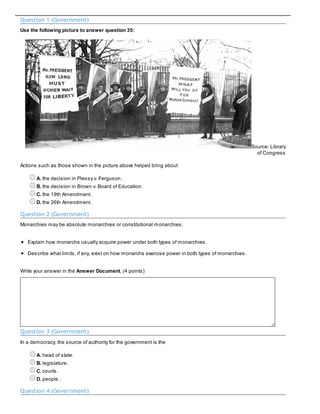Government
- 1. Question 1 (Government) Use the following picture to answer question 35: Source: Library of Congress Actions such as those shown in the picture above helped bring about A. the decision in Plessy v. Ferguson . B. the decision in Brown v. Board of Education. C. the 19th Amendment. D. the 26th Amendment. Question 2 (Government) Monarchies may be absolute monarchies or constitutional monarchies. Explain how monarchs usually acquire power under both types of monarchies. Describe what limits, if any, exist on how monarchs exercise power in both types of monarchies. Write your answer in the Answer Document. (4 points) Question 3 (Government) In a democracy, the source of authority for the government is the A. head of state. B. legislature. C. courts. D. people . Question 4 (Government)
- 2. A government in which the leader typically uses the threat of force to maintain control of the government is known as a A. dictatorship. B. presidential democracy. C. constitutional monarchy. D. parliamentary democracy. Question 5 (Government) Use the following photo to answer question 26. Actions taken by organizations such as those shown in the photo above helped bring about A. the decision in Plessy v. Ferguson. B. the decision in Brown v. Board of Education. C. the 19th Amendment to the U.S. Constitution. D. the 26th Amendment to the U.S. Constitution. Question 6 (Government) Use the following diagrams representing the structure of two forms of government to answer question 8. According to the information in the diagrams, what is the difference in the relationship between the executive and the legislature in the two types of democracies?
- 3. A. In a presidential democracy, the executive is more accountable to the legislature. B. In a presidential democracy, the legislature is more accountable to the executive. C. In a presidential democracy, the executive and the legislature are directly accountable to the citizens. D. In a presidential democracy, the executive and the legislature are less accountable to the citizens. Question 7 (Government) The primary feature of a dictatorship is that A. people are permitted to vote for more than one candidate. B. the executive branch has equal power with the legislative branch. C. judicial courts are replaced by military courts. D. leaders make decisions without the consent of the people. Question 8 (Government) One way the U.S. Constitution evolves is through the amendment process. How were the changes that occurred as a result of the ratification of the 19th and 26th Amendments similar? A. Large groups of people gained the right to vote. B. The right of individuals to bear arms was restricted. C. The powers of the federal government were expanded. D. The separation of church and state was more clearly defined.


